






Neopagan Wheel of Year with Winter Solstice/Yule

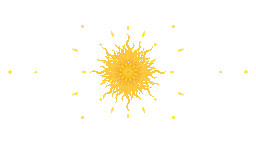
It is estimated that he rites of the Winter Solstice go back 25,000 years in the human past. These rituals had to do with the archaic worship of the rebirth of the sun at Winter Solstice. Thus the Winter Solstice was the turning point of time and the birthday of the sun, the moment of new beginnings. Winter Solstice observance of our ancient ancestors was a special time when the community could renew its connection with nature and its seasonal cycles; when people could come together and share in the great mystery of “the rebirth of the sun (or light) out of the womb of winter’s darkness.”

“Midwinter Day” is a modern Neoagan holiday (sabbat) that takes place at the time of the Winter Solstice. Some modern Neoagans use the term “Midwinter” as a general term for a holiday, encompassing traditional celebrations from a variety of mostly European cultures either to identify their own eclectic celebrations or to encompass the many types of celebrations found among their fellows, or both.
The Astronomy of the Winter Solstice
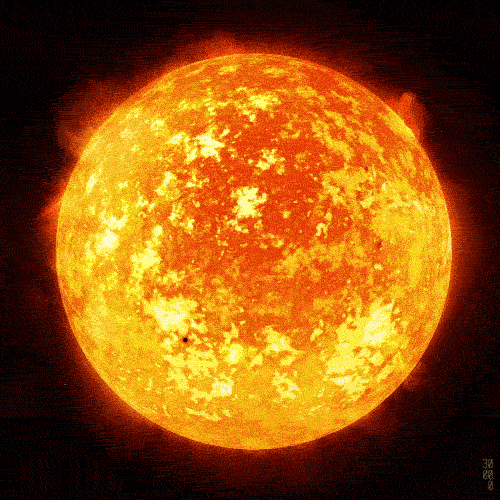

This year, 2024, the Winter Solstice occurs on Saturday, December 21, at 1:20 AM PST and 09:20 UTC.
The December solstice is when the Sun reaches its most southerly point and the moment the Sun is directly above the Tropic of Capricorn in the Southern Hemisphere. This is the southernmost latitude it reaches during the year. After the solstice, it begins moving north again.The Winter Solstice is the day with the fewest hours of sunlight in the whole year, making it the “shortest day” of the year. After the Winter Solstice is reached, the days begin to once again grow longer and longer until the Summer Solstice—the first day of summer and the longest day of the year. Although the Winter Solstice means the start of the Winter season, it also means the return of more sunlight, which seems somewhat paradoxical. The Winter Solstice marks the official beginning of “astronomical winter” (as opposed to “meteorological winter,” which starts about three weeks prior to the solstice).
At the December solstice, Earth is positioned so the sun stays below the North Pole’s horizon. As seen from the latitude 23 1/2 degrees south of the equator, at the imaginary line encircling the globe known as the Tropic of Capricorn, the sun shines directly overhead at noon. This is as far south as the sun ever gets, and all locations south of the equator have day lengths greater than 12 hours. The Winter Solstice in the Northern Hemisphere marks the 24-hour period with the fewest daylight hours of the year. That is why it is known as the shortest day of the year, or the longest night of the year. If you live in the Northern Hemisphere, you can notice the late dawns and early sunsets and the low arc of the sun across the sky each day. You might notice how low the sun appears in the sky at local noon. Around the time of the December solstice, it’s the longest noontime shadow of the year. The Winter Solstice is “the first day of Capricorn.” The Sun in Capricorn represents a new beginning of life force and resurrection from the dead of winter and a new initiatory power and strength as the days begin to increase in length. The present winter season in North America begins on the December 2024 Winter Solstice and ends on the March 2025 Vernal Equinox.
Celestial Dynamics of the Winter Solstice: The Seasons


Celestial Dynamics of the Winter Solstice: Earth's Axial Tilt & Procession of Equinoxes


Celestial Dynamics of the Winter Solstice: Sun-Earth Aphelion & Perihelion

Celestial Dynamics of the Winter Solstice: Earth's Orbital Path


Thematic Images of The Reason For the Winter Solstice Season


Many of the wintertime customs in Western Europe descended from the ancient Romans. The primary one from which the Christmas season descended was Saturnalia, an ancient Roman holiday celebrated at the Winter Solstice. This was a public holiday each year from December 17th to the 24th. It honored Saturn, the god of the harvest. The Romans believed that their harvest deity, Saturn, had ruled the land during an earlier age of rich crops, and so celebrated the Winter Solstice on Saturn’s promise of the return of the sun with a Saturnalia. This was high festival of public rites, gift-giving, role reversals, and a general mood of revelry and licentiousness. Riotous merrymaking took place, and the halls of houses were decked with boughs of laurel and evergreen trees. What had originated as a feast day later expanded into a weeklong festival full of music, dancing, banquets, drinking, games, and bonfires. The customary greeting for the occasion was “Io, Saturnalia!” (io, pronounced “yo,” being a Latin interjection related to “ho,” as in “Ho, praise to Saturn”).


For the Mayans, the Winter Solstice, rather than being considered as a dark day because of the shortest day of sun of the year (which falls on December 21) was seen as a symbol of renewal. The Mayans believed this day to be the rebirth of the sun for the upcoming year, knowing that from this day each following day will be sunnier than the last one. Because the Mayans welcomed the gradual return of the light, they knew spring was near, which comforted them; it was a time to reflect on the blessings that spring would bring.
The Mayans attached a huge importance to the sun for their daily life and religious beliefs. Indeed, they believed that the observation of the sky was essential to communicate with their gods in order to predict the time, what the gods needed and how the Mayans should honor them. Thus, the sun had an essential place in the Mayan culture and hierarchy. Astronomers were very numerous and as the king was titled with the name of the God of the Sun, this celestial body seemed to have an authority for both the religious and daily life calendar. The Winter Solstice and tracking the sun were about creating an understanding of the order of the universe and its place in it.
.jpg)
Mayan Winter Solstice (Teotihuacan pyramids near Mexico City)
.jpg)
Mayan Winter Solstice ceremony (Belize)

Kinich Ahau, Mayan sun god
Kinich Ahau is the Yucatec name of the Maya sun god believed to be the creator of light. He is thought to be an aspect of Itzamna, the supreme creator deity and ruler of heaven, day, and night. The radiant sun god, often incarnated as a potent ruler or a jaguar, Kinich Ahau ruled over music and poesy, bestowing creative inspiration. According to Mayan mythology, the god Itzamna is the god who created the world and the humans. But he is also often referred to as the God of the Sun, Kinich Ahau. Kinich Ahau was the god shining in the sky all day before turning into a jaguar once the sun came down to enter the Mayan Underworld, Xibalba. During the Classical Period, Kinich Ahau was used as a royal title, meaning the king had both the title of king and deity of the sun, showing how the sun was important to Mayan religion.






G S




.png)

.png)
Thematic Images for the Winter Solstice










G S

G S

G S




Thematic Images for Winter Solstice Landscapes







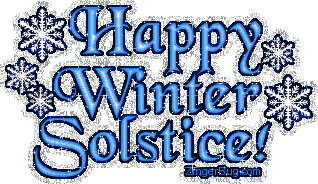
Thematic Images for Winter Solstice Blessings
.jpg)





G S







Thematic Images for the Return of the Sun King on the Winter Solstice


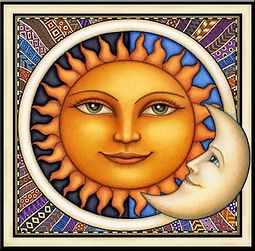




G S
Welcoming Back the Sun for Winter Solstice: The Sun King
The ancient pagans knew that the Winter Solstice was the longest night of the year ("Solstice Night") and that it meant the sun was beginning its long journey back towards earth. It was a time of celebration and rejoicing in the knowledge that soon the warm days of spring would return and the dormant earth would come back to life. It was out of the darkest night that the "Sun King" was reborn.
“The black moment is the moment when the real message of transformation is going to come. At the darkest moment comes the light.”
– Joseph Campbell.



To see two more images of the Winter Solstice Goddess with the Sun-Child, go to section below, "Thematic Images for Winter Solstice Goddess & Queen."



G S

G S
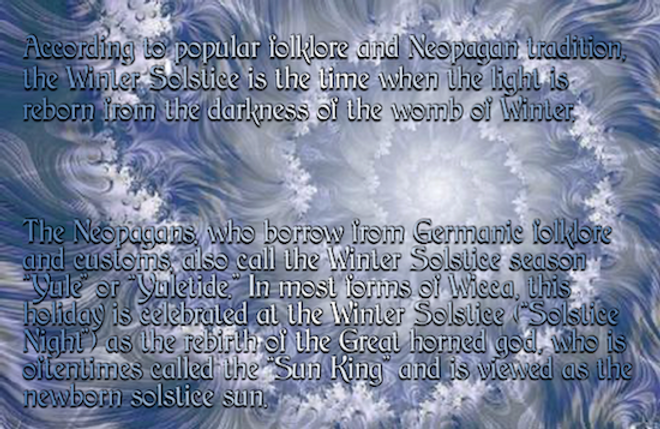
G S

G S














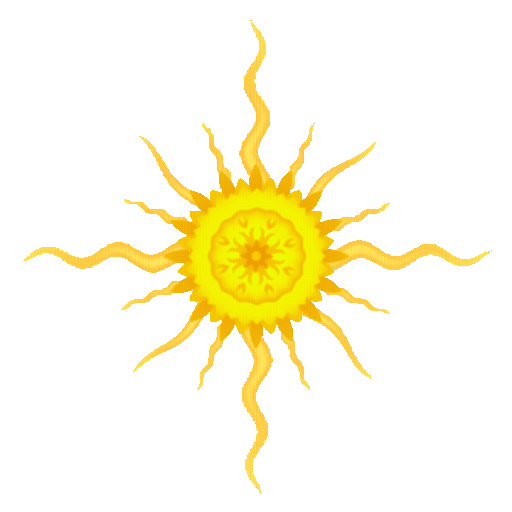
.jpg)
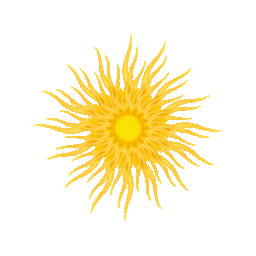
Here Comes The Sun (Doyle)

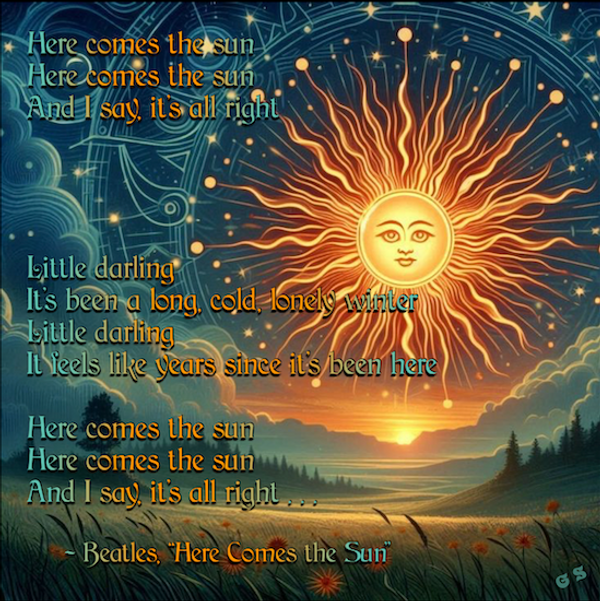
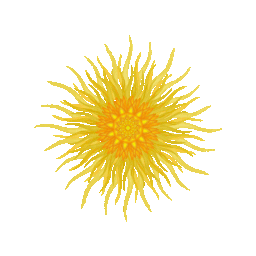
Thematic Images for the Celtic & Neopagan Winter Solstice


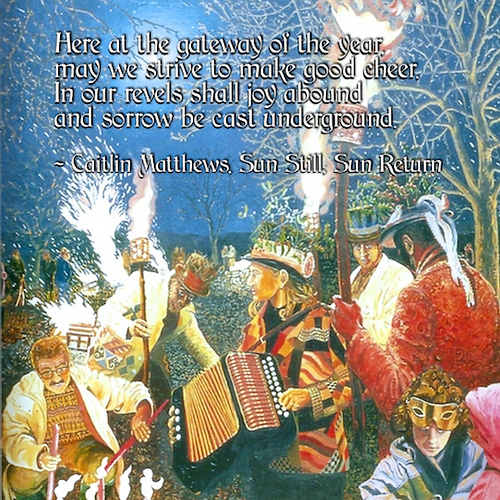

Northern traditional peoples and contemporary Neopagans celebrate the Winter Solstice as "Midwinter's Day" (the shortest day and longest night) and the entire midwinter season as "Yule".
At the Winter Solstice on Midwinter's Day, around four and a half minutes after sunrise, the rising sun shines down the "roof-box" (a specially contrived opening directly above the main entrance) directly along the long Neolithic passage graves of Newgrange (at County Meath, Ireland), illuminating the inner chamber and revealing the carvings inside, notably the triple spiral on the front wall of the chamber. This illumination lasts for approximately 17 minutes. As the room gets flooded with sunlight, it signaled that the days would start to get longer again. (When the monument was constructed, however, the first light would have occurred at sunrise in the form of a very narrow beam bisecting the chamber. Today the first light enters about four minutes after sunrise, but calculations based on the precession of the Earth show that 5,000 years ago, first light would have entered exactly at sunrise.) Newgrange predates the astronomical structures of Stonehenge by 1,000 years and as such may be the oldest astronomically orientated structure in the world.
The giant stones of the Neolithic monument (at Wiltshire, England) of Stonehenge, aligned to the movements of the sun, have marked the time of the Winter Solstice for some 3,000 years. The stones were shaped and set up to frame at least two important events in the annual solar cycle: the midwinter sunset at the Winter Solstice and the midsummer sunrise at the Summer Solstice. Stonehenge is carefully aligned on a sight-line that points to the Winter Solstice sunset (opposed to Newgrange, which points to the winter solstice sunrise, and the Goseck Circle, which is aligned to both the sunset and sunrise). It is thought that the Winter Solstice was actually more important to the people who constructed Stonehenge than the Summer Solstice. At Stonehenge, to this day, crowds of people, mostly Neopagans, arrive early on the solstice morning to watch the sun rise ("here comes the sun"). At the solstice sunset, it appears to set framed between the arches of the monument signifying the midwinter sunset.
.jpg)
Stonehenge
.jpg)
Newgrange
Thematic Images for Stonehenge







Thematic Images for Newgrange
.jpg)






The Newgrange Triple Spiral
The triple spiral was an integral symbol in ancient Celtic religion and spirituality. The symbol appears on several Celtic artifacts and sacred sites, most notably at Newgrange in Ireland. While the precise religious significance of the triple spiral to the ancient Celts remains a subject of debate, it’s generally agreed that it had spiritual connotations. It might have symbolized the three realms (earth, sky, sea), the stages of life (birth, death, rebirth), or the triple aspects of the divine feminine.
The triple spiral or the three swirl symbol is essentially another interpretation of the triskelion (derived from the Greek word “triskeles,” translating to “three-legged”). It refers to the version with three spirals joined at the center. This variant is often linked to the Celts’ pre-Christian era, prominently featuring in their megalithic art, such as the famous entrance stone at Newgrange in Ireland, a passage tomb built around 3200 BC. Scholars and cultural historians have interpreted each spiral in the triple spiral symbol differently. Some suggest it represents three Celtic worlds: the spiritual world, the present world, and the celestial world. Others propose that it denotes the three stages of life: birth, death, and rebirth. In Celtic culture, the triskele is a powerful symbol, often linked to the triadic nature of the Celtic belief system. The Celtic spiral of life is a central theme in Celtic art and symbolism, and it directly relates to the triskelion. This spiral is often considered a symbol of the life-death-rebirth cycle, eternal life, or the sun. It’s also thought to represent key triads in the Celtic perspective—land, sea, and sky; mind, body, and spirit; or the Celtic goddess as the maiden, mother, and crone. While many of these interpretations involve speculation, it’s clear that the Celtic triskele is a symbol of important three-part concepts or entities, such as the “Triple Goddess" of Celtic mythology.




Thematic Images for Winter Solstice Ceremonies
At the Winter Solstice, Neopagans (Neo-Druids, Wiccans, etc.) gather at the famous megalithic stone circle of Stonehenge to celebrate the sunrise at the shortest day of the year –- an event claimed to be more important on the pagan calendar than the Summer Solstice, because it marks the "rebirth of the Sun" for the New Year.








The Winter Solstice has been ritually celebrated by humankind for probably 25,000 years by various cultures around the world.
.jpg)
.jpg)
Winter Solstice sunrise at Temple of Karnak (Egypt)
Egyptian goddess Isis at the Winter Solstice
.png)
.jpg)
Winter Solstice Hopewell Indian Ceremony
(Midwestern U.S. 100 BCE to 500 CE)
Winter Solstice Celebrations from Around the World
To read image description, click on main image and then scroll through images
Thematic Images for Winter Solstice/Yule

The word Yule is the Norse/Germanic term for the pagan Winter Solstice. It is descended from the Old English geol or geola through the Middle English yole which referenced Christmastide (which includes the 12 days of Christmas) and was cognate to the Anglo-Saxon name for the entire midwinter season giuli which included December and January, — all evolved from the Old Norse jol which arose from the Proto-Germanic jehwlą, meaning “festivities” or “to play.” Thus, the word Yule at its root possibly means “the festivities” as related to the midwinter season. Yule and Yuletide are referring to the old Germanic Winter traditions surrounding Yule also spelled Jul or Jol. Many of our modern Christmas traditions originate in older Norse and Germanic pagan customs including the Yule log, evergreen tree, lights, and more.

%20meme.jpg)
















The Winter Solstice observance was an important ritual at this time of year,
a special time when community could come together and share in the great mystery of the rebirth of the sun out of the womb of winter’s darkness.
Thematic Images for Winter Solstice/Yule Longest Night


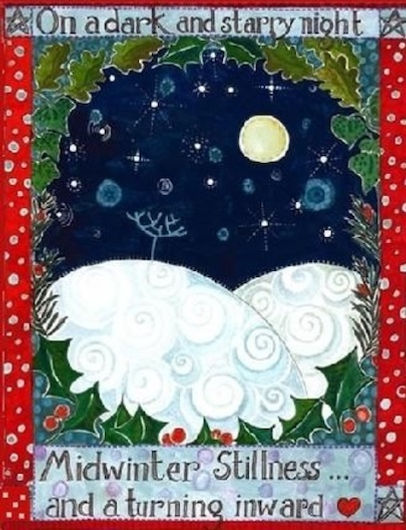




click on image to expand "Yule Time of Longest Night"



Thematic Images for Winter Solstice/Yule Celebrations

Thematic Images for the History of Yule and Yuletide: the Pre-History of Christmas
%2C%20Nordic%20Yule%20festival%20(Fikentscher%201880).jpg)
Die Gartenlaube (The Garden Arbor), Nordic Yule Festival (Fikentscher 1880)
%2C%20Nordic%20Yule%20festival%20(Fikentscher%201880)%202.jpg)

Ancient Germanic Yule festival
Thematic Images for (Slavic) Yule Celebrations

Thematic Images for Yule Log Celebrations

Thematic Images for Odin: the Prototype for Santa Claus

Thematic Images for the Norse Yule Goddess

Thematic Images for Winter Solstice/Yule Trees

Thematic Images for Winter Solstice/Yule Magic

Thematic Images for Neopagan Winter Solstice/Yule

Thematic Images for Winter Solstice/Yule Mandalas

Thematic Artwork for Winter Solstice/Yule
.jpg)
Winter Solstice (Philp)
.jpg)
Winter Solstice (Ryan)
.jpg)
Yule (Clark)
.jpg)
Gaia's Winter Rest (Andrew)
.jpg)
Magic Moment (Winter Solstice, Andrew)
.jpg)
Winter Solstice Goddess (Andrew)
.jpg)
.jpg)
Winter Solstice (Nelson)
Winter Solstice (Creese)
.jpg)
Winter Solstice (Brian)

Return of the Light - Winter Solstice Sunset

Winter Solstice Sun

Winter Solstice Sun

.jpg)

Winter Solstice Celebration
Solstice Celebrations (Hirons)
Thematic Images for Winter Solstice Goddesses, Maidens, and Spirits


Thematic Images for Winter Solstice Goddesses
.jpg)
Holding The New Born Sun (Andrew)
.png)
Solstice Goddess, Avalon, Glastonbury Tor (Livingstone)




The Snow Queen (Gerard)

.png)
Winter Solstice Light Bringer Goddess (Orpwood)





Thematic Images for Winter Solstice Goddess & Queen


Winter Solstice Goddess and Sun-Child
Winter Solstice Goddess and Sun-Child

Thematic Images for Winter Solstice Spirit, Shaman, & Witch

Thematic Images for Winter Solstice Fairies & Elves

Thematic Images for the Winter Solstice "Wild Hunt"

The “People/Phantoms of the Night” are roughly equivalent to the Celtic “faery folk” of the Otherworld. Associated with the medieval “Witchcraft” phenomenon, other magical elements accrued themselves onto this folklore complex of the “People/Phantoms of the Night,” such as: (1) the pan-European legend of the “Wild Hunt” of the “night-riders” (sometimes led by Herne the Hunter), who could be heard thundering through the countryside on horseback just above the ground or in the sky; (2) the legend of the pagan goddess of the Hunt, Diana (or “Holda”), who lured women to “night flying,” or nocturnal travels of riding upon wild beasts— “the game of Diana.”
December Wild Hunt scene

.jpg)
Wild Hunt (Arbo)


There is an old tale goes, that Herne the Hunter
(Sometimes a keeper here in Windsor forest)
Doth all the winter-time, at still midnight,
Walk round about an oak, with great ragg’d horns,
And there he blasts the tree, and takes the cattle,
And makes milch-kine yield blood, and shakes a chain
In a most hideous and dreadful manner.
You have heard of such a spirit, and well you know
The superstitious idle-headed eld
Receiv’d and did deliver to our age
This tale of Herne the Hunter for truth.
~ Shakespeare, The Merry Wives of Windsor
Herne The Hunter

G S
The Wild Hunt is an ancient folk-myth that is prevalent in all regions of the Boreal Forest (a circumpolar forest that rings the Northern Hemisphere, mostly north of the 50th parallel); in other words, across Northern, Western, and Central Europe. (There's also some evidence that the Wild Hunt folk-myth was operating in some North American Indian tribes. See image above.) Some folklorists contend that it may be as old as mankind itself.
There are many legends of the Wild Hunt, depending on where they originate. Besides Ireland, the Wild Hunt is known from the post-medieval folklore of Great Britain, Germany, Denmark, Sweden and Norway. The story of The Wild Hunt is a tale found throughout both Celtic and Norse folklore. In Welsh mythology, Arawn or Gwynn ap Nudd is the leader of the Wild Hunt. In all the tales, the Hunter-god and hunters are generally the same: a phantasmal, spectral group of huntsmen with the accouterments of hunting (horns, whips, bow and arrow, etc), with horses and hounds in mad pursuit across the wintery and stormy night skies or just above the ground. The retinue wild hunters may be the dead or the fairies. Seeing the Wild Hunt was thought to presage some catastrophe such as war or plague, or death of the one who saw it. Mortals getting in the path of or following the Hunt could be kidnapped and brought to the land of the dead or into the realm of the Fae.
After the Winter Solstice, we logically transition into Yuletide or Christmas.
This is because Yule or Christmas occurs during the Winter Solstice season. ("Yuletide" refers to the Christmas season, or the period of time around Christmas. Thus, synonyms of Yuletide include Christmas and Christmastide. Yuletide can also refer to a pre-Christian festival associated with the Winter Solstice that was later incorporated into Christmas. Modern neopagans sometimes recreate this festival.)

once again: Father Frost & Snow Maiden
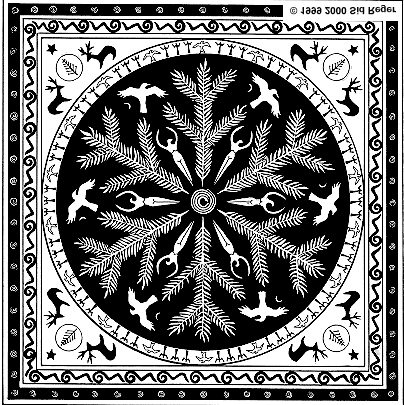

G S
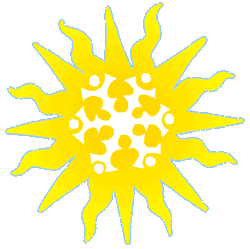






































































%201.jpg)
%203.jpg)
%205.jpg)


%202.jpg)
%204.jpg)



%20meme.jpg)

































































































































































.jpg)
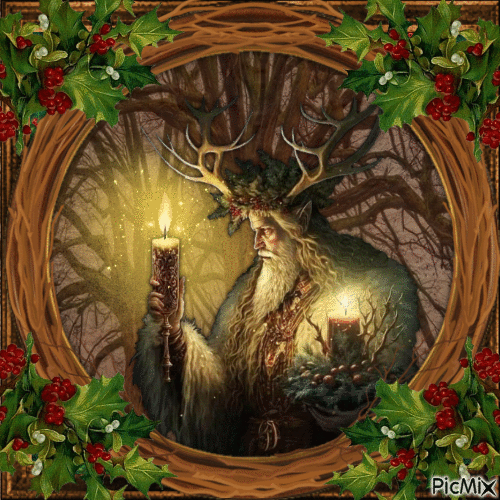




.jpg)

































